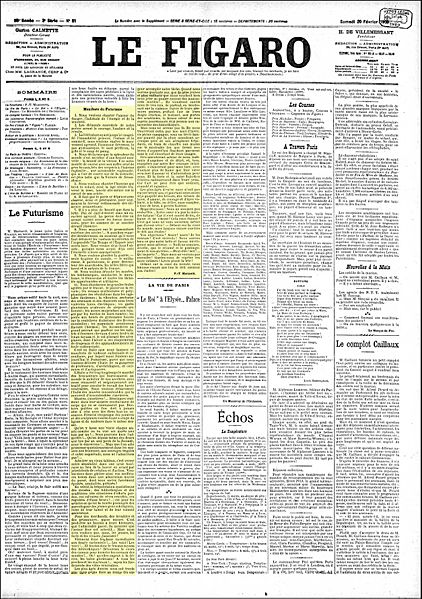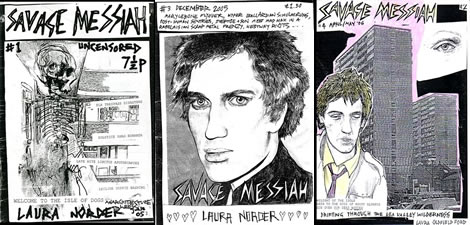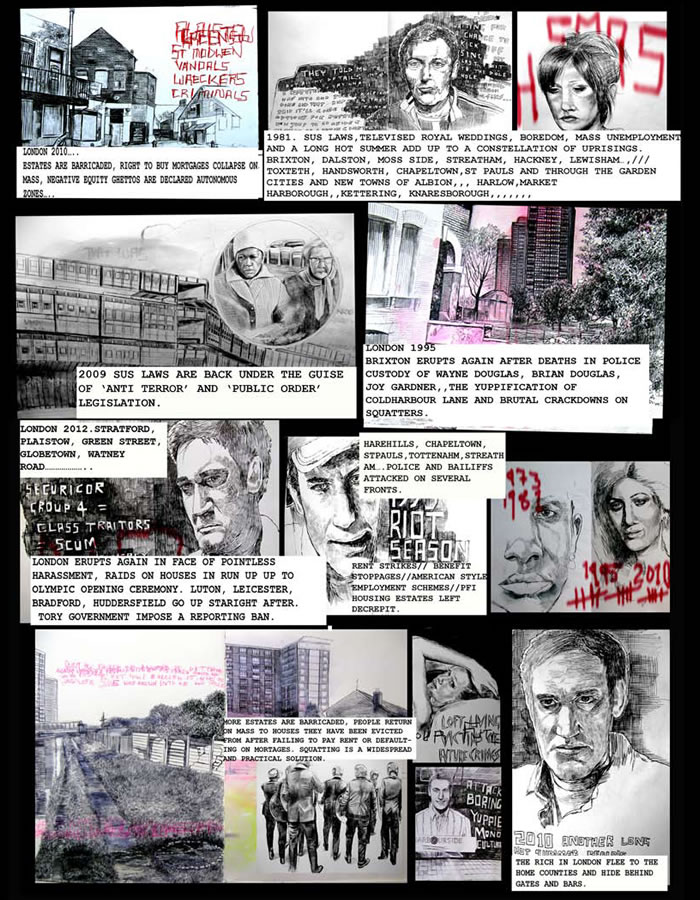Jacques Derrida is the most important philosopher of the movement usually called deconstruction, often associated with poststructuralism. Derrida, famous for a sustained interrogation of both the content and the form of Western philosophical discourse (and Western culture more generally). Derrida's philosophical project sought to undermine and expose the underlying binary oppositions of Western thought including speech/writing, presence/absence – and (why not?) art/philosophy. Derrida's work has often been understood to walk the line between literary and theoretical expression and analysis.
Derrida's texts often take unusual and inventive forms, with his book Glas often understood as the most audacious attempt, which, through the use of visual layout in columns, juxtaposed an analysis of Hegelian philosophy with avant-garde pkaywright Jean Genet's autobiographical works. It apparently drew its textual form from Genet's Ce qui est resté d'un Rembrandt déchiré en petits carrés bien réguliers, et foutu aux chiottes ("What Remains of a Rembrandt Torn Into Four Equal Pieces and Flushed Down the Toilet").
The left hand column is about Hegel and the right hand about Genet. Each column has inset into it a series of further quotations that are juxtaposed with Derrida's own text.
Monday, 7 April 2014
Monday, 24 March 2014
Laura Oldfield Ford
Another contemporary artist who combines the theoretical, the literary and the visual is Laura Oldfield Ford, whose work focuses on an exploration of the politics of development and the urban landscape, in the "psychoegeographic" tradition of the artists of the Situationist International.
Part of her practice has been the production of a zine (which ran from 2005-9) and then a blog, entitled Savage Messiah.
Here's her blog:
http://lauraoldfieldford.blogspot.co.uk/
A book version of Savage Messiah was published by Verso in 2011 - see Verso's website here:
http://www.versobooks.com/books/1022-savage-messiah
From the New Statesman's review of this, by Sukhdev Sandhu:
“One of the most striking fanzines of recent years is Laura Oldfield Ford’s Savage Messiah, focussing on the politics, psychology and pop- cultural past of a different London postcode. Ford’s prose is scabrous and melancholic, incorporating theoretical shards from Guy Debord and Marc Augé, and mapping the transformations to the capital that the property boom and neoliberalist economics have wrought. Each zine is a drift, a wander through landscape that echoes certain strands of contemporary psychogeography. Ford—or a version of her, at least—is an occasional character, offering up narcotic memories of a forgotten metropolis. The images, hand-drawn, photographed and messily laid out, suggest both outtakes from a Sophie Calle project and the dust jacket of an early 1980s anarcho-punk compilation record: that is, both poetry and protest.”
Friday, 21 March 2014
Futurist Manifesto
We're discussing Marx and the Communist Manifesto in class this week. In what sense was the Communist Manifesto an artwork, a literary rather than simply political, theoretical or philosophical text? In what sense has it been an influence and a model for the explosion of artistic manifestos of the twentieth century?
The most famous, most seminal of the avant-garde art manifestos was the Futurists' Manifesto, published in the french newspaper Le Figaro, 5 Feb 1909.
The full text of the manifesto is here:
http://vserver1.cscs.lsa.umich.edu/~crshalizi/T4PM/futurist-manifesto.html
For more artists' Manifestos, see Alex Danchev's book 100 Artists' Manifestos: From the Futurists to the Stuckists (London: Penguin, 2011).
The most famous, most seminal of the avant-garde art manifestos was the Futurists' Manifesto, published in the french newspaper Le Figaro, 5 Feb 1909.
 |
| Futurist Manifesto, marked in yellow, on the front page of Le Figaro, 5 Feb 1909. |
http://vserver1.cscs.lsa.umich.edu/~crshalizi/T4PM/futurist-manifesto.html
For more artists' Manifestos, see Alex Danchev's book 100 Artists' Manifestos: From the Futurists to the Stuckists (London: Penguin, 2011).
Mary Kelly, "Post Partum Document"
Mary Kelly's Post Partum Document (1973-9) is another classic conceptualist re-articulation of the relation between text and image / theory and art – though this time from a feminist persepctive.
The work traces the development of the mother-child relationship between her and her child, starting in 1973. It provoked tabloid outrage in its initial presentation at the ICA in 1976 because of its use of soiled nappies!
The work is interesting for weaving together a series of different kinds of text (the first words and graphic marks of the child, her own personal voice as a mother, psychoanalytical/feminist theory, and the more bureaucratic discourses of the medical, etc. professions which "write" ordinary people's experience.
More can be found about the work on Kelly's website:
http://www.marykellyartist.com/post_partum_document.html
Mary Kelly, Post Partum Document, detail. Perpsex units, white card, wool vests, pencil, ink
1 of 4 units, 20 x 25.5 cm each.
Another detail. Perpsex units, white card, diaper linings, plastic sheeting, paper,ink
31 units, 28 x 35.5 cm each
Anther detail. Perpsex unit, white card, wood, paper, ink, rubber. 1 of the 26 units, 20 x 25.5 cm. Collection, Art Gallery of Ontario
The work traces the development of the mother-child relationship between her and her child, starting in 1973. It provoked tabloid outrage in its initial presentation at the ICA in 1976 because of its use of soiled nappies!
The work is interesting for weaving together a series of different kinds of text (the first words and graphic marks of the child, her own personal voice as a mother, psychoanalytical/feminist theory, and the more bureaucratic discourses of the medical, etc. professions which "write" ordinary people's experience.
More can be found about the work on Kelly's website:
http://www.marykellyartist.com/post_partum_document.html
Mary Kelly, Post Partum Document, detail. Perpsex units, white card, wool vests, pencil, ink
1 of 4 units, 20 x 25.5 cm each.
Another detail. Perpsex units, white card, diaper linings, plastic sheeting, paper,ink
31 units, 28 x 35.5 cm each
Anther detail. Perpsex unit, white card, wood, paper, ink, rubber. 1 of the 26 units, 20 x 25.5 cm. Collection, Art Gallery of Ontario
Monday, 17 February 2014
Van Gogh's letters
Another monumental work of writing by an artist is Van Gogh's correspondence - especially to his brother Theo - which often provide detailed commentary not only on his life but his artistic endeavours.
They are all now available online...
http://vangoghletters.org/vg/letters/let001/letter.html
They are all now available online...
http://vangoghletters.org/vg/letters/let001/letter.html
Robert Smithson

Another artist who used writing very effectively as part of their practice was the "land" artist Robert Smithson. Smithson's work already played on the complexity of the "presence" of the gallery artwork, which he defined as a "non-site" in relation to which an actual "site" which was usually situated in the landscape quite some distance from the gallery. The "artwork exists somewhere between the gallery and the outside space of the work.
Smithson's most famous work is Spiral Jetty (1970).

An example of his writing is the essay (?) "Tour of the Monuments of Passaic", which was published in Artforum in 1967. In it Smithson takes the reader on a tour of the mundane physical structures of a small-town, (post-)industrial New Jersey landscape, where the disintegrating and ramshackle industrial landmarks are re-imagined as monuments from the present-day in order to meditate on the themes of time and entropy (the "winding down of the universe") which his work is concerned with.
The essay is available here:
http://gd1studio2011.files.wordpress.com/2011/09/smithson-monuments-of-passaic.pdf
The photo-essay in Artforum was also paralleled by the exhibition of the photos themselves as "artworks", and these are currently in the collection of the Museet for Samtidkunst, Norway.
http://www.robertsmithson.com/photoworks/monument-passaic_300.htm
Michael Craig-Martin - An Oak Tree
Michael Craig Martin's An Oak Tree (1973) was another seminal piece of conceptual art that played with the relation between an artwork and a text. Here the text serves not to describe the work, but to change its effect, exploring the declarative or "performative" aspects of language.

The text exhibited along with the glass of water reads:
http://www.tate.org.uk/art/artworks/craig-martin-an-oak-tree-l02262/text-summary

The text exhibited along with the glass of water reads:
Q. To begin with, could you describe this work?
A. Yes, of course. What I’ve done is change a glass of water into a full-grown oak tree without altering the accidents of the glass of water.
Q. The accidents?
A. Yes. The colour, feel, weight, size …
Q. Do you mean that the glass of water is a symbol of an oak tree?
A. No. It’s not a symbol. I’ve changed the physical substance of the glass of water into that of an oak tree.
Q. It looks like a glass of water.
A. Of course it does. I didn’t change its appearance. But it’s not a glass of water, it’s an oak tree.
Q. Can you prove what you’ve claimed to have done?
A. Well, yes and no. I claim to have maintained the physical form of the glass of water and, as you can see, I have. However, as one normally looks for evidence of physical change in terms of altered form, no such proof exists.
Q. Haven’t you simply called this glass of water an oak tree?
A. Absolutely not. It is not a glass of water anymore. I have changed its actual substance. It would no longer be accurate to call it a glass of water. One could call it anything one wished but that would not alter the fact that it is an oak tree.
Q. Isn’t this just a case of the emperor’s new clothes?
A. No. With the emperor’s new clothes people claimed to see something that wasn’t there because they felt they should. I would be very surprised if anyone told me they saw an oak tree.
Q. Was it difficult to effect the change?
A. No effort at all. But it took me years of work before I realised I could do it.
Q. When precisely did the glass of water become an oak tree?
A. When I put the water in the glass.
Q. Does this happen every time you fill a glass with water?
A. No, of course not. Only when I intend to change it into an oak tree.
Q. Then intention causes the change?
A. I would say it precipitates the change.
Q. You don’t know how you do it?
A. It contradicts what I feel I know about cause and effect.
Q. It seems to me that you are claiming to have worked a miracle. Isn’t that the case?
A. I’m flattered that you think so.
Q. But aren’t you the only person who can do something like this?
A. How could I know?
Q. Could you teach others to do it?
A. No, it’s not something one can teach.
Q. Do you consider that changing the glass of water into an oak tree constitutes an art work?
A. Yes.
Q. What precisely is the art work? The glass of water?
A. There is no glass of water anymore.
Q. The process of change?
A. There is no process involved in the change.
Q. The oak tree?
A. Yes. The oak tree.
Q. But the oak tree only exists in the mind.
A. No. The actual oak tree is physically present but in the form of the glass of water. As the glass of water was a particular glass of water, the oak tree is also a particular oak tree. To conceive the category ‘oak tree’ or to picture a particular oak tree is not to understand and experience what appears to be a glass of water as an oak tree. Just as it is imperceivable it also inconceivable.
Q. Did the particular oak tree exist somewhere else before it took the form of a glass of water?
A. No. This particular oak tree did not exist previously. I should also point out that it does not and will not ever have any other form than that of a glass of water.
Q. How long will it continue to be an oak tree?
A. Until I change itThere's more about the work here:
http://www.tate.org.uk/art/artworks/craig-martin-an-oak-tree-l02262/text-summary
Monday, 10 February 2014
Fiona Banner - film descriptions
 |
| Fiona Banner, Apocalypse Now, 1997, installation view (above) and detail (below). |
Sunday, 9 February 2014
Stéphane Mallarmé
The other week we also discussed the poems of Stéphane Mallarmé, precursor of concrete poetry. Mallarmé died in 1898, but was a key inspiration for a number of avant-garde movements such as the Dadaists and the Surrealists. As well as a poet Mallarmé was a critic and theorist.
Mallarmé's experiments with visual / poetic form challenged the boundaries between media/disciplines, and also stand as a themselves a theoretical investigation into the nature of poetry, language, art and thought.
Barbara Johnson has written of Mallarmé's influence on theory:
"It was largely by learning the lesson of Mallarmé that critics like Roland Barthes came to speak of 'the death of the author' in the making of literature. Rather than seeing the text as the emanation of an individual author's intentions, structuralists and deconstructors followed the paths and patterns of the linguistic signifier, paying new attention to syntax, spacing, intertextuality, sound, semantics, etymology, and even individual letters. The theoretical styles of Jacques Derrida, Julia Kristeva, Maurice Blanchot, and especially Jacques Lacan also owe a great deal to Mallarmé's 'critical poem.'" (Barbara Johnson, "Translator's Note," Stéphane Mallarmé, Divagations [Cambridge, Mass: Harvard UP, 2007], 301.)
Art Writing
What is writing when it becomes art and art when it becomes writing?
Here's a manifesto from the team that run the Art Writing MFA at Godlsmiths, which claims to be for "practitioners who want to develop work that addresses art as writing, writing as art, and writing about art". This is part of the movement for the development of a genre called "art writing".
http://blog.frieze.com/11-statements-around-art-writing/
Here's a manifesto from the team that run the Art Writing MFA at Godlsmiths, which claims to be for "practitioners who want to develop work that addresses art as writing, writing as art, and writing about art". This is part of the movement for the development of a genre called "art writing".
http://blog.frieze.com/11-statements-around-art-writing/
Vienet - Can Dialectics Break Bricks? / Guy Debord's Society of the Spectacle
Rene Vienet was associated with the Situationists – an ultra-radical artistic/theoretical movement of the 50s and 60s. Vienet's Can Dialectics Break Bricks? (1973) appropriated a kung fu movie – a piece of capitalist culture – replacing its dialogue with fragments of Situationist theories, and refunctioning it as an allegory of the student unrest of the late 1960s, as well as the fate of Stalinism, with the film's good guys and bad guys renamed "revolutionaries" and "bureaucrats" respectively.
You can watch the whole film on Vimeo here.
Guy Debord, the leader of the Situationists also transformed his theoretical magnum opus, The Society of the Spectacle (1968) into a film, montaging its text, as a voiceover, with a collage of fragments from the capitalist media his book critiques:
You can watch the whole film on Vimeo here.
Guy Debord, the leader of the Situationists also transformed his theoretical magnum opus, The Society of the Spectacle (1968) into a film, montaging its text, as a voiceover, with a collage of fragments from the capitalist media his book critiques:
Syed Alavi
Syed Alavi is an Iranian installation artist whose work often works with text (and against text) - foregrounding the materiality of the text.
http://here2day.netwiz.net/seyedsite/installations/drawntolight/drawntolightframe.html
Gary Hill
Gary Hill is an elecronic / sound / video artist, whose work often plays between text and image in a series of different ways
Site Recite (1989)
and here's another work:
Mediations (1986)
Art & Language
 |
| the front cover of Art-Language's first edition, in 1969 |
Art & Language was (and still is) a long-running and fluid collaboration of conceptual artists started in 1969. The group was formed around their journal Art-Language, the first edition of which claimed to be "the journal of conceptual art". It was here that Conceptual Art as a term was first coined. The collaborations or conversations of this group took the form of both artworks and essays, and often their artistic work included strong textual elements, blurring the boundaries between "theory" and "practice".
They are very much worth looking up.
The group is represented by the Lisson Gallery and examples of their work can be seen on the website there.
There's also an interesting discussion, and images, of their work "Now They Are Surrounded, which involved the placement of paintings of typewritten text within the Guidhall Gallery in London, which is available here:
http://systemsart.org/a_ltext.html
Here we have a double relation between art and text - the text in the art, and the essay on the art... (Are they the same?)
A more detailed discussion of the work by the artists, and its stakes was published as "Now They Are Surrounded" in the Journal of Visual Art Practice 6.1 (2007) - and available in full text / PDF form through the Art Full Text database.
Joseph Kosuth - One and Three Chairs *plus* "Art After Philosophy"
 |
| Joseph Kosuth, One and Three Chairs (1965) |
A seminal essay proposing that art is a form of – or, rather, replaces the function of – philosophy is Joseph Kosuth's "Art after Philosophy". It is very much recommended reading. For Kosuth, the primary question of art is what art is, which is pursued "through artistic means".
The essay is available via UBUWeb here.
His classic work One and Three Chairs (1965, pictured above) plays wittily on Plato's discussions of art in the Republic, to question the nature of representation, and to probe Plato's suggestion that it is only philosophy (and the word), rather than art (and the image), that offers us "truth" or conceptual knowledge.
Welcome!
Welcome! This blog will collate resources of works that bring together the visual and textual for students on FNA2330 and FNA3260 at Middlesex University to draw on in their own work, if they so wish.
Subscribe to:
Posts (Atom)









